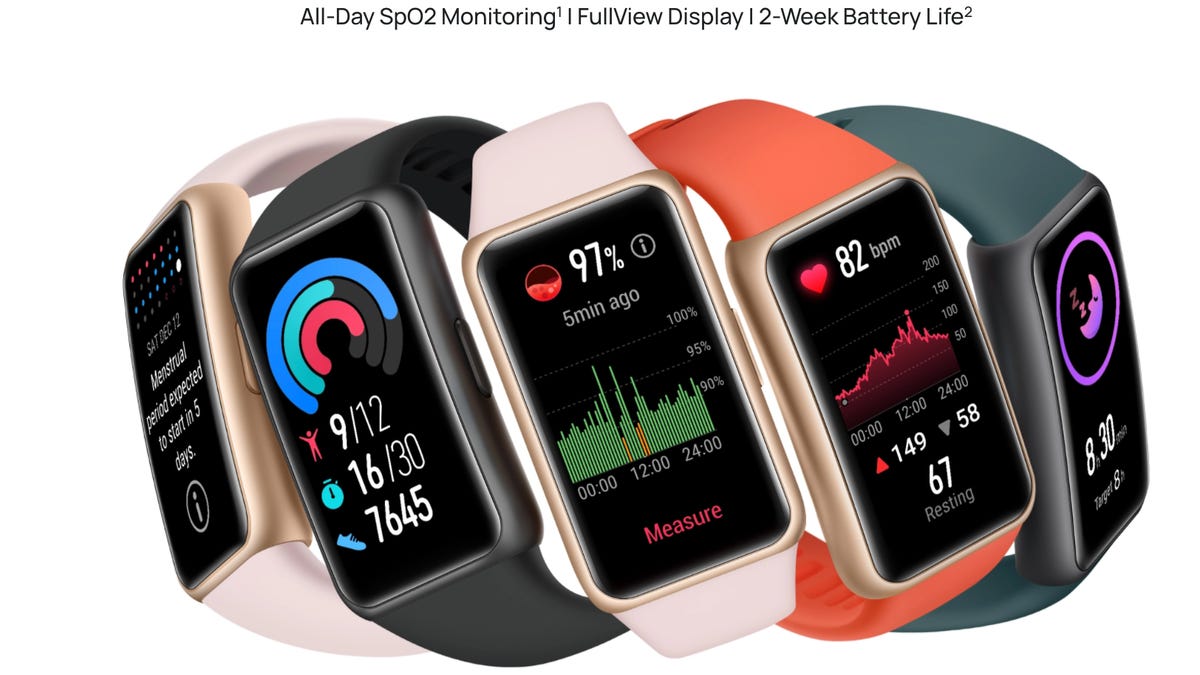Huawei Band 6 hands-on: Smartwatch experience at a fitness tracker price
Consider the Band 6 if you're looking for a versatile sub-$100 fitness tracker.

Huawei's Band 6 is available in four colors.
Huawei's Band 6 is one of the latest fitness bands to bring a wealth of impressive features to your wrist on the cheap. I spent a week or so testing Huawei's new wrist wearable, paired up with an Android smartphone, and found that it offers a versatile and intuitive experience. It's also verging on smartwatch territory thanks in part to the larger design, sophisticated health features and relatively comprehensive health tracking.
For £59 (roughly $80, AU$110) the Huawei Band 6 offers basic smartwatch features including phone notifications and heart-rate monitoring, plus advanced health features such as all-day blood oxygen monitoring, sleep tracking, menstrual tracking, and a battery that's advertised to last for 14 days.
The Band 6 is available in the UK along with several Asian, Middle Eastern and European countries. Keep in mind, pricing tends to vary based on the market. The Band 6 isn't officially available in the US, but you might be able to find it on Amazon or eBay.
Band 6 wears like a smartwatch
Partly because of its relatively large and wide screen, the Band 6 makes you think you're wearing a smartwatch instead of a fitness tracker . It also uses one of the better displays I've seen on a fitness tracker: a bright AMOLED panel that offers solid resolution (368x194 pixels) and is visible in sunny conditions. The 1.47-inch screen makes it easy to flick through notifications or messages and read them, but you can't reply to text messages or answer calls. The straps are crafted with silicone and rested comfortably on my wrist, but you can't swap them out for other colors or replace them in case of damage.
The Band 6 also tracks a whopping 96 different workout types. You can track everything, from more common exercises, such as outdoor walks and yoga, to out-of-the-ordinary activities including kite-flying, dragon-boating and laser tag. But I should caveat this with the fact that less common workouts won't give you any additional or exercise-specific data points beyond the basics, which include heart rate, calories burnt, exercise time and training stress. Tracking an outdoor run, on the other hand, will serve up more useful running data like pace and stride length.
Just like the OnePlus Watch, Huawei's Watch 6 breaks out your heart rate zones based on intensity during workouts so I could see how hard I was working in each exercise I loved knowing whether I was in say, fat-burning mode or anaerobic mode to help me get a better sense of the workout's intensity. I don't own a chest strap, the gold standard for tracking your heart rate during a workout, so I wasn't able to cross-check the heart rate data. Unfortunately, the Band 6 could not track my go-to workout here in Hong Kong, which is hiking, as a barometer sensor for measuring altitude is absent, so I used outdoor walk mode. To be fair, that's a feature normally reserved for more premium devices or smartwatches. But the Band 6's 5ATM IP68 rating means it's water-resistant down to 50 meters.
Huawei Health app is the companion app for the Band 6. Here you can see how it tracks the various sleep stages.
Basic and advanced health features
The Band 6 sports a feature that's been thrust into the spotlight due to the pandemic: blood oxygen monitoring. Huawei is advertising it as an all-day feature, but I'm afraid it didn't work using the app (though Huawei will likely fix that with an update), but you can measure your SpO2 levels manually. I didn't have a pulse oximeter on hand either to cross-check the numbers, but you should take the results with a grain of salt since a fitness tracker is not a replacement for a medical device like an oximeter. Either way, it's evolving into a must-have feature and was a welcome addition to the Band 6.
Beyond blood-oxygen tracking, other health features included cycle monitoring, stress tracking and heart-rate monitoring courtesy of the optical heart-rate sensor. Native sleep monitoring was one of my favorite features on the Band 6. Basic sleep data can be gleaned directly from the Band 6, and on the Huawei Health app you get more data on sleep stages, duration, and awake time.
Impressive battery life
I haven't had the chance to put the Band 6 through two full weeks of testing, but so far it's poised to deliver on its 14-day battery life promise. After eight days of mild use, battery life is still holding up strong at 40%. Comparable fitness trackers such as Xiaomi 's Mi Band 6 and Honor's Band 6 have similar advertised battery life, but this is still miles ahead of the Apple Watch SE and Galaxy Watch Active 2 smartwatches, which don't go past the two-day mark. Not needing to charge the Band 6 every night before bed is convenient for sleep tracking. Once you run out of juice, you'll need to use Huawei's proprietary charger to refill the battery.
Key specs
- 1.47-inch AMOLED display (94x368-pixel display)
- All-day heart-rate monitoring, blood oxygen monitoring, sleep tracking, cycle tracking
- 14-day battery life
- Water-resistance down to 50 meters
- Weight: 18 grams (without straps)
- Dimensions: 43x25.4x10.99 mm

